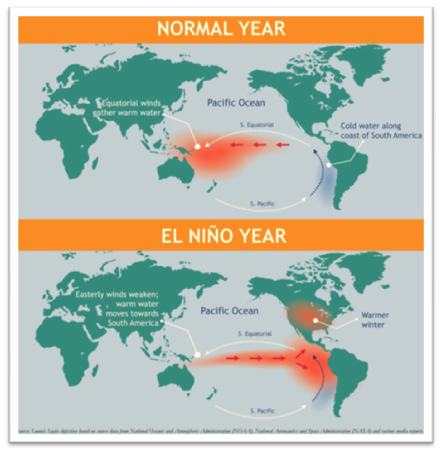
CURRENT AFFAIRS – 27/01/2024
- CURRENT AFFAIRS – 27/01/2024
- What is the legal dispute over AMU’s minority status?
- Why is there no snowfall in Kashmir?
- India-France defenceties take a bigger leap
- Jet engine deal with France will give 100% access to technology
- Chandrayaan helped moon lander make pinpoint landing, says Japan
- Rare golden tiger snapped in Kaziranga
- Union govt. makes it clear that Aadhaarcard no proof of citizenship, birth date
CURRENT AFFAIRS – 27/01/2024
What is the legal dispute over AMU’s minority status?
(General Studies- Paper II)
Source : TH
A seven-judge Bench of the Supreme Court, led by Chief Justice of India D.Y. Chandrachud, is currently engaged in a pivotal hearing regarding the 57-year-long dispute over the minority character of the Aligarh Muslim University (AMU).
Key Highlights
- Understanding ‘Minority Character’:
- The core of this legal discourse revolves around Article 30(1) in Part III of the Constitution, which bestows upon religious and linguistic minorities a fundamental right to establish and administer educational institutions of their choice.
- The second clause of Article 30 ensures that the State maintains ‘equality of treatment’ when providing aid to all educational institutions, irrespective of their minority status.
- This encompasses institutions spanning from primary schools to professional education.
- Exemptions and Privileges:
- Educational institutions holding minority character are exempted from implementing reservations for Scheduled Castes (SC), Scheduled Tribes (ST), and Other Backward Classes (OBC) in both admissions and employment.
- Moreover, they have the prerogative to reserve up to 50% of seats for students from their community.
- Additionally, these institutions enjoy greater autonomy in the selection and control of employees compared to non-minority institutions.
- A significant clarification provided by the Supreme Court, particularly in the T.M.A Pai Foundation (2002) case, is that the determination of a ‘minority’ status is contingent upon the demography of the concerned State, rather than the national population.
- This underscores the contextual nature of defining minority status within the diverse fabric of India.
- Historical Background of Aligarh Muslim University (AMU) Legal Dispute
- The legal dispute surrounding Aligarh Muslim University (AMU) has a deep historical context, dating back to its founding in 1877 by Sir Syed Ahmed Khan, a Muslim reformer.
- Originally established as the Muhammadan Anglo-Oriental College (MAO College) in Aligarh, the institution aimed to address educational backwardness among Muslims while preserving Islamic values.
- The transformative Aligarh Muslim University Act, 1920 (AMU Act) incorporated MAO College and the Muslim University Association into AMU.
- Amendments and Shifts in Governance:
- In 1951, the AMU Act underwent amendments, removing compulsory religious education for Muslims and the exclusive Muslim representation mandate in the University Court.
- Further amendments in 1965 redistributed powers among various bodies, including the executive, with the President of India nominating members to the governing body.
- These changes marked a shift in the governance structure of AMU.
- Genesis of the Legal Dispute (1967):
- The legal dispute commenced in 1967 when the Supreme Court, in the case of S. AzeezBasha versus Union of India (UOI), reviewed the 1951 and 1965 amendments.
- The petitioners argued for the right of Muslims to manage AMU, asserting that it was established by the Muslim minority.
- However, a five-judge Supreme Court bench upheld the amendments, contending that AMU was not established or administered by the Muslim minority, emphasizing its enactment through Central legislation.
- This ruling sparked nationwide protests.
- In response to the protests and legal developments, the AMU Act was amended in 1981 to explicitly affirm the university’s minority status.
- This legislative move aimed to settle the debate over the nature of AMU’s establishment and administration.
- Reservation Controversy (2005-2006):
- In 2005, AMU implemented a reservation policy, reserving 50% of postgraduate medical seats for Muslim candidates.
- However, the Allahabad High Court, in the case of Dr Naresh Agarwal vs UOI (2005), struck down the reservation policy, deeming the 1981 amendment ultra vires (beyond the legal authority).
- Consequently, in 2006, both the UOI and the University appealed to the Supreme Court.
- However, in 2016, the UOI withdrew from the appeal, refusing to acknowledge the University’s minority status.
- Consequently, AMU is currently pursuing the case independently, leading to the ongoing legal deliberations before the Supreme Court.
- Supreme Court Deliberations
- The Supreme Court is intricately examining the criteria that should be employed to ascertain the minority status of educational institutions.
- Additionally, the court is probing whether an institution, such as AMU, established under a statute, can legitimately claim minority status.
- These issues hold broader implications for the legal recognition of minority institutions across the country.
- Petitioners’ Argument for Minority Status:
- The petitioners, advocating for AMU’s entitlement to minority status, contend that the institution was established by the Muslim community and should be recognized as such.
- Senior Advocate Rajeev Dhavan referred to the T.M.A Pai Foundation verdict, asserting that statutory regulations or State aid, as received by AMU, do not negate its minority character.
- It was emphasized that the legislative act merely ‘incorporated’ the university rather than altering its ‘establishment’ by the minority community under Article 30 of the Constitution.
- Government’s Position:
- Solicitor General Tushar Mehta, representing the Union of India, endorsed the S. AzeezBasha verdict, arguing that AMU, over time, transitioned into a ‘loyalist’ institution that surrendered its rights to the British government.
- Mehta contended that the enactment of the 1920 Act transformed AMU into a secular institution.
- However, Chief Justice of India (CJI) D.Y. Chandrachud intervened, emphasizing that AMU’s political history should not impact its minority status.
- The judgment in this case is anticipated to establish a precedent that could significantly influence the rights and legal recognition of all minority educational institutions.
- The Supreme Court’s careful consideration of the intricate legal and historical aspects of this case underscores its broader implications for the legal landscape surrounding minority institutions in India.
About Article 30
- Article 30 of the Indian Constitution provides specific rights and protections to minorities, both religious and linguistic, in the realm of education.
- Enacted to safeguard the interests of minority communities, this constitutional provision encompasses various facets that ensure autonomy and equal treatment for minority educational institutions.
- Key Provisions of Article 30:
- Right to Establish and Administer Educational Institutions:
- Minority communities, whether religious or linguistic, are granted the fundamental right to establish and administer educational institutions of their choice.
- Protection Against Compulsory Acquisition:
- The 44th Amendment Act of 1978 introduced a vital protection by stating that the compensation amount fixed by the State for the compulsory acquisition of any property of a minority educational institution shall not restrict or abrogate the rights guaranteed to them.
- This safeguard was crucial after the deletion of the right to property as a Fundamental Right (Article 31).
- Non-Discrimination in State Aid:
- When providing aid, the State is prohibited from discriminating against any educational institution managed by a minority.
- This ensures equal treatment in terms of financial assistance for minority educational institutions.
- Scope of Protection and Right to Impart Education in Own Language:
- The protection under Article 30 is specifically limited to minorities (religious or linguistic) and does not extend to any section of citizens, as outlined in Article 29.
- Article 30 includes the right of a minority to impart education to its children in its own language, preserving cultural and linguistic diversity.
- Categories of Minority Educational Institutions:
- Seeking Recognition and Aid:
- Institutions falling under this category seek both recognition and financial aid from the State.
- Seeking Only Recognition:
- Some institutions seek recognition from the State but not financial aid.
- Neither Seeking Recognition nor Aid:
- Institutions of this type neither seek recognition nor financial aid from the State.
- Regulatory Framework for Different Types:
- Institutions of the first and second types are subject to the regulatory power of the state concerning various aspects such as syllabus prescription, academic standards, discipline, and employment of teaching staff.
- Institutions of the third type have the freedom to administer their affairs but are subject to general laws like contract law, labour law, industrial law, tax law, economic regulations, etc.
- Seeking Recognition and Aid:
- Right to Establish and Administer Educational Institutions:
Why is there no snowfall in Kashmir?
(General Studies- Paper I and III)
Source : TH
The winter of January in Kashmir, Himachal Pradesh, and Uttarakhand, known for their picturesque snow-clad landscapes, has taken an unexpected turn with an unusual lack of snowfall.
- Popular skiing destinations like Gulmarg and Pahalgam in Kashmir and various mountain resorts in Himachal Pradesh are experiencing dry conditions, impacting winter sports and the usual scenic beauty of the region.
Key Highlights
- Normally snow-covered areas like Gulmarg and Pahalgam are devoid of snow, disrupting winter sports activities.
- Dry slopes and valleys with brown grass characterize Himachal Pradesh’s mountain resorts.
- Record Driest January in Himachal Pradesh:
- The India Meteorological Department (IMD) reports Himachal Pradesh witnessing its driest January since 1901, with a significant 99.7% shortfall in January rain compared to the historical average.
- The previous record for the driest January was in 1996, which reported a 99.6% shortfall.
- Causes for Lack of Snowfall:
- Low Atmospheric Moisture:
- Snowfall requires adequate moisture and atmospheric temperatures at or below 0 degrees Celsius.
- Despite low temperatures since December, the region experienced a shortfall in moisture.
- Temperature Anomalies:
- Analysis by the IMD in mid-January revealed maximum temperatures 5-8 degrees Celsius below normal over North India since December 29.
- Minimum temperatures were below 4 degrees Celsius in many stations in Northwest India throughout January.
- Factors Influencing Snowfall:
- A drastic fall in the number of Western Disturbances over Northwest India impacted the usual snowfall patterns.
- Prevailing El Niño conditions contributed to the unusual weather patterns.
- The absence of a strong jet stream further contributed to the lack of snowfall and intense cold waves over North India.
- Factors Influencing Snowfall Patterns:
- Influence of Western Disturbances (WDs):
- WDs, originating in mid-latitude regions and traversing thousands of kilometers, bring rains to northern India.
- In winter, WDs dissipate fog, increase ground sunshine, and can lead to snowfall when temperatures are low.
- WDs contribute to snowmelt, crucial for water availability in rivers like Ganga, Indus, and Yamuna.
- However, the absence of WDs this winter has resulted in an 80% reduction in rain in the Western Himalayan Region.
- Role of El Niño Conditions:
- Prevailing El Niño conditions over the equatorial Pacific Ocean, marked by warmer temperatures, may influence weather patterns.
- Regardless of El Niño or its counterpart, La Niña, the number of WDs in December and January has generally been declining.
- The winter of 2022-2023 witnessed India’s hottest December on record, with the northwest reporting an 83% rainfall deficit.
- Changing WD Patterns and Climate Change:
- The conventional pattern of WDs has been disrupted since 2019, with extended dry periods and intense wet spells.
- Meteorologists and climate scientists attribute these disruptions to global warming, emphasizing the impact on regional weather patterns.
- Climate change-induced variations in WD behavior contribute to instances of altered precipitation, affecting both dry and wet spells.
- Impact on Agriculture and Water Resources:
- WDs can result in hail, posing a threat to standing wheat crops.
- Typically, five to seven WDs affect Northwest India from December to January.
- The absence of WDs during this winter has prevented the usual beneficial effects on crops, impacting agricultural outcomes.
- Climate Change Trends:
- The disruption in WD patterns is indicative of broader climate change trends, leading to unpredictable and extreme weather events.
- Instances of rising WDs in February and March contribute to flash floods, particularly in regions like Uttarakhand and Himachal Pradesh.
- Jet Streams’ Role in Winter Weather Patterns:
- Jet streams, powerful high-altitude winds crucial in shaping weather patterns, play a significant role in influencing winter conditions over North India.
- Their role in carrying Western Disturbances (WDs) and their interaction with moisture sources impacts temperature dynamics and cold air patterns.
- Recent observations indicate a connection between jet stream behavior and the warming of the Arctic seas, leading to noteworthy changes in their traditional characteristics.
- Key Functions of Jet Streams:
- Jet streams, characterized by speeds ranging from 250 to 320 km/hr, transport WDs, influencing weather conditions in North India.
- The current lack of moisture has led jet streams to contribute to the subsidence of cold air, intensifying the cold over North India.
- Jet streams typically establish themselves after the monsoon withdrawal, drawing moisture from the Arabian Sea to influence winter weather patterns.
- Recent years have seen a northward shift in the traditional position of jet streams, altering their influence on weather conditions.
- Emerging research suggests that the observed northward shift in jet streams is linked to the warming of the Arctic seas.
- Warming in the Arctic affects the natural temperature gradient, influencing the strength and direction of jet streams.
- Implications for Winter Weather in North India:
- The current lack of moisture, combined with the altered behavior of jet streams, contributes to dry conditions and reduced snowfall in regions like Kashmir, Himachal Pradesh, and Uttarakhand.
- Understanding the intricate relationship between jet streams and climate factors like Arctic warming is crucial for predicting and adapting to changing winter weather patterns.
- Shifting jet stream dynamics can have cascading effects on regional climates, emphasizing the broader impact of climate change on atmospheric circulation.
- Influence of Western Disturbances (WDs):
- Low Atmospheric Moisture:
Understanding the Geography
- Western Disturbances (WDs):
- Western Disturbances are low-pressure systems or extratropical storms that originate over the Mediterranean region and move eastwards across the northern parts of the Indian subcontinent.
- They are a crucial weather phenomenon for countries like India, Pakistan, and neighboring regions.
- Western Disturbances bring moisture from the Mediterranean and can cause rainfall, snowfall, or thunderstorms in the affected areas.
- These disturbances play a significant role in the winter precipitation over northern India and contribute to the advancement of the winter monsoon.
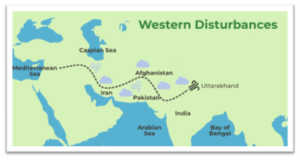
- El Niño:
- El Niño is a climate pattern characterized by the periodic warming of sea surface temperatures in the central and eastern equatorial Pacific Ocean.
- This warming disrupts normal atmospheric circulation patterns, affecting weather conditions globally.
- During El Niño events, there tends to be an increase in sea surface temperatures, leading to altered weather patterns, such as changes in rainfall, temperature, and storm activity.
- El Niño events can have widespread impacts on agriculture, fisheries, and weather-related disasters in various parts of the world.
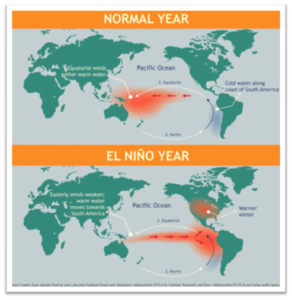
- Jet Streams:
- Jet streams are fast-flowing, narrow air currents in the atmosphere, typically found at high altitudes in the troposphere.
- The two main jet streams are the polar jet stream and the subtropical jet stream.
- These winds flow from west to east and play a crucial role in steering weather systems and influencing surface weather patterns.
- Jet streams are associated with the boundaries between air masses of different temperatures, and they can have a significant impact on the development and movement of storms.
- The position and strength of jet streams can influence weather conditions at the surface.
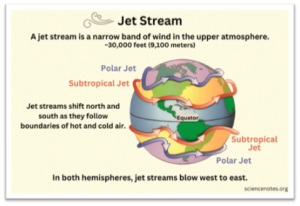
India-France defenceties take a bigger leap
(General Studies- Paper II)
Source : TH
India and France have unveiled a “defense industrial roadmap” to enhance cooperation in defense production.
- The roadmap includes plans for co-design and co-development of military hardware.
- The collaboration aims to achieve parity with the India-U.S. defense production plan finalized the previous year.
- Prime Minister Narendra Modi and French President Emmanuel Macron discussed and finalized these agreements during talks in Jaipur on January 25.
Key Highlights
- French President Macron’s 30-hour visit to India included discussions on defense, space, and various other partnerships.
- Defense-Space Partnership:
- A new agreement for a defense-space partnership was signed, focusing on collaboration in space situational awareness.
- The partnership also includes an MoU on coordinating satellite launches.
- The space cooperation aligns with India’s efforts to enhance its space capabilities.
- While major government-to-government deals on fighter-jets, engines, and submarines were not announced, a joint venture for local manufacture of civilian helicopters between Airbus and TATA was confirmed.
- Progress on mega multi-billion dollar defense deals, including 26 Rafale-M fighter jets for the Indian Navy and three additional Scorpene-class submarines, is reportedly in the cost negotiation phase.
- Focus Areas in Defense Cooperation:
- The defense industrial roadmap prioritizes co-designing, co-developing, and co-producing defense equipment.
- Domains of collaboration include aircraft, land and maritime warfare (with a focus on underwater domain awareness), space, robotic technology, cyber-defense, and artificial intelligence-led vehicles.
- The roadmap aims to build defense supply chains and contribute to security partnerships with other countries requiring similar products.
- In addition to defense and space cooperation, India and France signed agreements in various sectors, including energy, digital health, agriculture, and education.
- Civil Nuclear Cooperation Agreement:
- There was no reported breakthrough on the civil nuclear cooperation agreement between India and France, signed in 2009, for building reactors at Jaitapur.
- Ongoing discussions between French company EDF and the Nuclear Power Corporation of India Ltd (NPCIL) involve technical, engineering elements, financing mechanisms, and ensuring localization of supplies.
- Strategic Partnership and Defense Industrial Roadmap:
- The defense industrial roadmap with France mirrors India’s joint efforts with the U.S. for co-design and co-development of military systems.
- The partnership with France includes a willingness to transfer jet engine technology, showcasing the depth of the strategic relationship.
About India-France Relations
- India and France, sharing a common vision and values, have built a robust partnership over the past 25 years.
- The strategic journey began in 1998, leading to a multifaceted alliance with shared views on international affairs.
- Economic Ties:
- Economic ties have flourished, with bilateral trade reaching $13.4 Bn in 2022-23, witnessing a significant 7.72% increase from the previous year.
- France stands as the 11th largest investor in India, with a noteworthy FDI inflow of $10.5 Bn from April 2000 to March 2023.
- Defense Cooperation:
- Defense cooperation serves as the keystone of the strategic alliance, with joint exercises enhancing interoperability and coordination.
- France has been a crucial ally in India’s defense modernization, evidenced by the acquisition of 36 Rafale fighter aircraft in 2016 and the P-75 Scorpene submarine project involving the construction of six submarines.
- Aerospace Research and Space Exploration:
- The partnership extends to aerospace research and space exploration, fostering innovation, technological advancements, and mutual growth.
- Notable collaborations include the Indo-French Centre for Aerospace Research and Innovation (IFCAR), promoting R&D in aerospace technologies.
- Joint research programs and satellite launches by the French Space Agency (CNES) and the Indian Space Research Organisation (ISRO) highlight the depth of collaboration.
- France has provided technical assistance in the construction of the Sriharikota launch-pad, solidifying the longstanding bond in space exploration and technological advancement.
- Smart Cities Collaboration:
- The collaboration extends to smart cities, aligning with India’s Smart Cities Mission launched in 2015.
- Ambitious initiatives and projects include the French Development Agency (AFD) extending a EUR 100 Mn ($112 Mn) loan to support India’s Smart Cities Mission.
- Key cities like Chandigarh, Puducherry, and Nagpur have been identified for joint development, with a commitment of $2.2 Bn for the project.
Jet engine deal with France will give 100% access to technology
(General Studies- Paper III)
Source : TH
India is engaged in discussions with France on manufacturing an engine for India’s fifth-generation fighter jet, specifically for the Advanced Medium Combat Aircraft (AMCA).
- The ongoing talks involve collaboration between Safran, a French multinational in aerospace and defense, and India’s Defence Research and Development Organisation’s Aeronautical Development Agency and Gas Turbine Research Establishment.
Key Highlights
- Set of Specifications:
- Safran, DRDO’s Aeronautical Development Agency, and Gas Turbine Research Establishment are working on defining a set of specifications that align with India’s future fighter jet requirements.
- The decision to collaborate on the engine development was announced during Prime Minister Modi’s visit to France in July 2023.
- Indian envoy to France, Jawed Ashraf, emphasized that the collaboration seeks more than just a transfer of manufacturing technology.
- The aim is to work on the actual design phase, metallurgical aspects, and other critical elements, with Safran expressing willingness for a 100% transfer of technology in design, development, certification, production, and more.
- The collaboration underscores the depth of the strategic partnership between India and France in the aerospace and defense sectors.
- The focus is on advancing beyond traditional technology transfer to actively participating in the design and development phases, marking a significant shift in the collaboration approach.
- Deal with General Electric (GE) for F-414 Engine:
- India has a deal with General Electric (GE) for the manufacturing license of the already-operational F-414 engine.
- The F-414 engines are intended for the indigenous Light Combat Aircraft (LCA)-MK2 and the initial version of the AMCA.
- The agreement with GE will enable Hindustan Aeronautics Limited in India to manufacture the F-414 engines.
- The deal has received approvals from the U.S. government, and finalization of commercial agreements is underway.
- The GE deal provides India access to various technologies and industrial processes involved in jet engine manufacturing.
- It is expected to enhance the capabilities of both public and private industries in India, contributing to the development of indigenous jet engine technology.
- Challenges in Jet Engine Technology:
- Jet engine technology is closely guarded globally due to its criticality in modern warfare.
- India’s past attempts, such as the Kaveri project initiated in 1989, aimed at local jet engine development but faced challenges and was eventually shelved.
- The now-closed Kaveri project incurred significant expenditure over 30 years, with nine full prototype engines and four core engines developed.
- Two-Phase Development of AMCA:
- The AMCA development is planned in two phases: MK1 with the F-414 engine and MK2 with a more powerful engine in collaboration with France.
- The collaboration with France and licensing agreements with GE represent significant steps in India’s pursuit of advanced jet engine capabilities.
Chandrayaan helped moon lander make pinpoint landing, says Japan
(General Studies- Paper III)
Source : TH
Japan’s space agency, the Japan Aerospace Exploration Agency (JAXA), has officially confirmed the successful pinpoint landing of its moon lander, the Smart Lander for Investigating Moon (SLIM), on January 19.
- JAXA initially faced challenges in confirming the landing precision due to a failure in the spacecraft’s solar panels, preventing power generation.
- The confirmation was delayed until officials could assess the situation, but it was eventually affirmed that the lander had indeed achieved a controlled descent without damage to other components.
Key Highlights
- With SLIM’s successful landing, Japan became the fifth country to soft-land a robotic instrument on the moon.
- India’s Chandrayaan 3 achieved a similar success in August 2023.
- SLIM’s Unique Design and Mission:
- SLIM was designed to be lightweight and followed a unique, fuel-efficient trajectory toward the moon.
- The primary mission of SLIM was to achieve a precision landing within a small 100 m by 100 m patch on the lunar surface, setting it apart from previous landers.
- SLIM earned the nickname “moon sniper” due to its mission’s focus on precision landing within a tiny designated area, a departure from the broader landing zones used in previous moon and Mars missions.
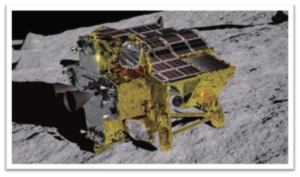
In Image: An artist’s impression of JAXA’s SLIM moon-lander on the lunar surface.
- Analysis of SLIM’s Lunar Landing
- The Smart Lander for Investigating Moon (SLIM) by JAXA was within 10 m of its designated landing spot until it reached an altitude of 50 m above the lunar surface.
- At this critical stage, SLIM utilized maps of the moon’s surface obtained by the orbiter of the Chandrayaan 2 mission conducted by India.
- SLIM’s computer overlaid these maps with images captured by its navigation camera to identify and navigate around potential obstacles during descent.
- SLIM’s statement revealed that one of its main engines failed during the descent, causing a deviation from its designated landing spot.
- The positional accuracy increased from 3-4 m during the first obstacle detection to 10 m in the second, indicating a potential link between engine failure and the deviation.
- Following the engine failure, SLIM’s onboard computer attempted to control the lander’s position using the remaining engine.
- Despite the descent velocity being within the design range, conditions such as lateral velocity and attitude were outside the planned parameters.
- The engine failure caused SLIM to drift approximately 55 m east of the designated spot where it eventually landed.
- Investigations are ongoing to determine if the engine failure is related to the solar panels’ inability to generate power.
- Technology Demonstration Success:
- Despite the challenges, SLIM’s statement emphasized that the technology demonstration of pinpoint landing within an accuracy of 100 m, declared as the main mission, has been achieved.
- The successful utilization of orbiter data and the ability to navigate and adjust during descent showcase the resilience of SLIM’s technology.
- Chandrayaan 2 Mission Overview:
- The Indian Space Research Organisation (ISRO) launched the Chandrayaan 2 mission in July 2019 with the primary objective of achieving a soft landing on the moon’s surface.
- Although the mission successfully entered lunar orbit in August, the attempted soft landing in September failed, resulting in the crash of the lander.
- Despite the lander’s setback, the Chandrayaan 2 orbiter has continued to orbit the moon, conducting scientific studies and creating a detailed map of the lunar surface.
- Success of Chandrayaan 3 Mission:
- Chandrayaan 3, ISRO’s subsequent lunar mission, successfully achieved a soft landing on the moon’s south pole region.
- The Chandrayaan 2 orbiter played a crucial role by providing images that aided the Chandrayaan 3 lander in its successful landing.
- Upcoming Collaboration with JAXA:
- The Japan Aerospace Exploration Agency (JAXA) and ISRO are expected to collaborate on the Lunar Polar Exploration (LUPEX) mission.
- LUPEX is set to be a lunar surface mission, and SLIM’s (Smart Lander for Investigating Moon) recent pinpoint landing will provide valuable insights for the LUPEX lander.
- The LUPEX lander, like SLIM, will be required to soft-land in the challenging terrain of the moon’s South Pole region, known for its uneven surface and craters with permanently shadowed areas where water ice is expected to be found.
About Chandrayaan 3- An Overview
- Chandrayaan-3 is the third mission in the Chandrayaan program, a series of lunar exploration missions developed by the Indian Space Research Organisation (ISRO).
- The mission was launched on July 14, 2023, and successfully landed near the moon’s South Pole on August 23, 2023.
- It consists of a lunar lander named Vikram and a lunar rover named Pragyan, similar to those launched aboard Chandrayaan-2 in 2019.
- The mission’s objectives are to achieve a safe landing on the lunar surface, demonstrate rover operations, and perform scientific experiments on site.
- The mission is aimed at the lunar South Pole, a region with water ice, which could be a source of oxygen, fuel, and water.
- The lander and rover are equipped with science instruments designed to deepen our understanding of the moon’s surface and environment
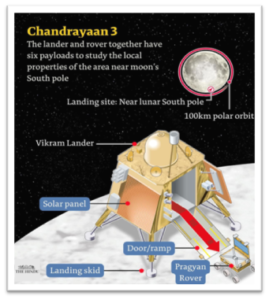
Rare golden tiger snapped in Kaziranga
(General Studies- Paper III)
Source : TH
Wildlife photographer Gaurav Ramnarayanan from Coimbatore captured a photograph of a golden tiger during a safari in Assam’s Kaziranga National Park.
- Gaurav Ramnarayanan mentioned that more than one tiger with a golden coat is believed to be present in Kaziranga, though the exact count is unknown.
Key Highlights
- Professor Uma Ramakrishnan of the National Centre for Biological Sciences, Bengaluru, is conducting a study on the golden phenotype of tigers in Kaziranga using scat samples.
- The golden tiger’s appearance is attributed to a mutation or genetic variant, resulting in the absence of black color and a slightly faded orange color.
- The ongoing research aims to understand the genetic basis and characteristics of tigers with the golden phenotype in Kaziranga.
About the Golden Tiger

- The term “golden tiger” is often used to describe a tiger with a unique coat coloration that differs from the typical orange and black pattern seen in most tigers.
- Golden tigers have a coat that appears in shades of gold, with variations ranging from pale gold to a deeper, richer golden hue.
- The golden coloration is due to a genetic variation that affects the pigmentation of the fur.
- The golden color is a result of a rare genetic mutation that affects the distribution of pigments in the fur.
- In a typical tiger, the orange color comes from the pigment pheomelanin, and the black stripes result from the pigment eumelanin. The golden tiger lacks or has reduced black pigmentation.
- Golden tigers are extremely rare in the wild, and their occurrence is primarily associated with captive breeding programs.
- While golden tigers are captivating and unique, they are not a separate subspecies. Instead, they are Bengal tigers (Pantheratigristigris) with a distinct coloration.
- It’s important to note that golden tigers are not the result of albinism or leucism. Albino tigers lack pigmentation altogether, appearing white with pink eyes, while leucistic tigers have a partial loss of pigmentation but may still have faint stripes.
About Kaziranga National Park
- Kaziranga National Park is situated in the Golaghat and Nagaon districts of Assam, India.
- Home to two-thirds of the world’s Indian rhinoceros population, the park is recognized as a UNESCO World Heritage Site.
- As of March 2018, a joint census conducted by the Forest Department of Assam and wildlife NGOs reported a rhino population of 2,613 in Kaziranga National Park.
- Historical Significance:
- The history traces back to 1904 when Mary Curzon, Baroness Curzon of Kedleston, influenced her husband, Lord Curzon, the Viceroy of India, to protect the diminishing one-horned rhinoceros population in the area.
- On June 1, 1905, the Kaziranga Proposed Reserve Forest was established, covering an initial area of 232 km².
- Over the next three years, the park’s area was extended by 152 km², reaching the banks of the Brahmaputra River.
- In 1908, it was designated a “Reserve Forest,” and by 1916, it became the “Kaziranga Game Sanctuary.”
- In 1934, the name was briefly changed to Kaziranha, but some still refer to it by its original name.
- Renamed as the “Kaziranga Wildlife Sanctuary” in 1950 by P. D. Stracey to eliminate hunting connotations.
- Stringent penalties for rhinoceros poaching were imposed by the Assam (Rhinoceros) Bill in 1954.
- In 1968, the Assam National Park Act was passed, declaring Kaziranga a designated national park, covering 430 km².
- Recognized for its unique natural environment, Kaziranga was declared a UNESCO World Heritage Site in 1985.
- Kaziranga is home to a variety of wildlife, including elephants, tigers, wild water buffalo, swamp deer, and numerous bird species.
- The park’s location along the Brahmaputra River contributes to its rich and diverse ecosystem.
- Predominantly characterized by expansive grasslands and wetlands, creating an ideal habitat for herbivores.
Union govt. makes it clear that Aadhaarcard no proof of citizenship, birth date
(General Studies- Paper II)
Source : TH
New Aadhaar cards and their PDF versions now carry a more explicit disclaimer stating that they serve as “a proof of identity, not of citizenship or date of birth.”
- The disclaimer signals to government departments and organizations not to use Aadhaar for purposes related to citizenship or date of birth.
Key Highlights
- Background on Aadhaar:
- Aadhaar has never been considered proof of citizenship, and even foreign nationals residing in India for over six months are eligible to obtain one.
- Despite its intended use as proof of identity, different government departments accept Aadhaar for purposes such as date of birth verification.
- Challenges to Previous Allowances:
- While Aadhaar was accepted by the Election Commission of India as proof of date of birth for voter enrollment, the new clarifications may challenge such allowances.
- The Aadhaar cards now include a warning that offline authentication requires scanning the QR code on the reverse side or using an XML file issued by the Unique Identification Authority of India (UIDAI), the authority administering Aadhaar.
- 2018 Memorandum:
- In 2018, the Ministry of Electronics and Information Technology issued a memorandum explicitly stating that Aadhaar is “per se … not a proof of date of birth.”
- The date of birth relies on a separate document provided by Aadhaar applicants.
- The invalidity of Aadhaar for establishing the date of birth and citizenship has been a long-standing acknowledgment.
- December 2023 Circular:
- In December 2023, the Unique Identification Authority of India (UIDAI) issued a circular referencing a Bombay High Court judgment that emphasized Aadhaar’s limitations in proving date of birth.
- The circular served as a reminder to organizations.
- The warning makes it clear that Aadhaar should not be considered as proof of date of birth, in addition to the existing clarification regarding citizenship.
- Aadhaar, with its 12-digit unique identification number, serves as a proof of uniqueness and residence.
About Aadhaar
- Aadhaar, meaning “foundation” in Hindi, is a unique identification system introduced by the Indian government to provide a universal identity to residents.
- It aims to assign a 12-digit unique identification number to each resident, facilitating easier access to government services and improving the efficiency of service delivery.
- The UIDAI, established in 2009, is the regulatory body responsible for issuing Aadhaar numbers and authentication processes.
- UIDAI maintains a centralized database containing demographic and biometric information of Aadhaar holders.
- During enrollment, individuals provide biometric data (fingerprints and iris scans) along with demographic information (name, date of birth, address).
- Upon successful enrollment, individuals receive a unique 12-digit Aadhaar number.
- Aadhaar allows authentication through fingerprint and iris scans for various services.
- Uses and Acceptance:
- Government Services: Aadhaar is widely used for accessing government services, subsidies, and benefits.
- Financial Transactions: Aadhaar is linked to bank accounts and used for financial transactions and subsidies.
- Telecom and SIM Card Verification: Aadhaar is used for verifying identity in telecom services and obtaining a new SIM card.
- Digital Identity: Aadhaar serves as a digital identity for online transactions and e-authentication.
Note: In 2018, the Supreme Court of India upheld the constitutional validity of Aadhaar but imposed restrictions on its mandatory use.